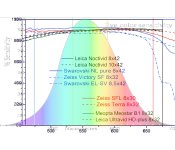Owlbarred
Well-known member

Despite the data for the models below, I've seen a statement on BF that the Nikon is dimmer than the Zeiss. If so, then the manufacturer-provided data are misleading or there is more than meets the eye. I'm confused.
Model.................. % light transmission
Zeiss SLF 10x40............. 90%
Nikon HG 10x42............. 92%
Model.................. % light transmission
Zeiss SLF 10x40............. 90%
Nikon HG 10x42............. 92%
Last edited:







